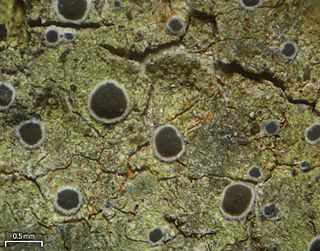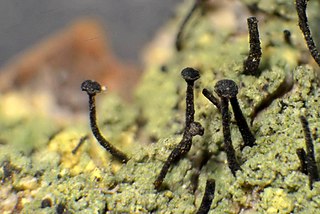
The Pilocarpaceae are a family of crustose lichens in the order Lecanorales. The species of this family have a cosmopolitan distribution and have been found in a variety of climatic regions. Pilocarpaceae was circumscribed by Alexander Zahlbruckner in Adolf Engler's influential 1905 work Die Natürlichen Pflanzenfamilien.
Cratiria is a genus of lichen-forming fungi in the family Caliciaceae. The genus has a widespread distribution, especially in tropical regions, and contains about 20 species. The genus was circumscribed by Austrian lichenologist Bernhard Marbach in 2000, with Cratiria lauri-cassiae assigned as the type species.

Amandinea is a genus of lichenized fungi in the family Caliciaceae. Genetic studies indicates that the genus Amandinea and Buellia are the same, although this is not widely accepted.

Hafellia is a genus of lichen-forming fungi in the family Caliciaceae. The genus has a widespread distribution, especially in tropical regions. The genus is named in honour of the Austrian lichenologist Josef Hafellner. The genus was proposed by the German lichenologist Klaus Kalb in 1986 to contain two bark-dwelling species, formerly in genus Buellia, with callispora-type spores. These ascospores have ridged walls, and are thin walled at their tips at early states of their differentiation.

Gassicurtia is a genus of lichenized fungi in the family Caliciaceae.

Stigmatochroma is a genus of lichenized fungi in the family Caliciaceae. The genus has a widespread distribution, and contains 9 species.

Bulbothrix is a genus of lichen-forming fungi in the family Parmeliaceae. This genus is synonymous with Bulbothricella V.Marcano, S.Mohali & A.Morales. Bulbothrix was circumscribed by lichenologist Mason E. Hale in 1974 with Bulbothrix semilunata as the type species.
Rhymbocarpus is a genus of lichenicolous (lichen-dwelling) fungi in the family Cordieritidaceae. It has 10 species. The genus was circumscribed by German mycologist Friedrich Wilhelm Zopf in 1896, with Rhymbocarpus punctiformis assigned as the type species.

Catolechia is a genus of lichen-forming fungi in the family Rhizocarpaceae. It is a monotypic genus, containing the single species Catolechia wahlenbergii. The genus was circumscribed by German botanist Julius von Flotow in 1850. He did not assign a type species for the genus; Catolechia pulchellaA.Massal. (1852) was designated as the type by Gustav Wilhelm Körber in 1855. This species is synonymous with Catolechia wahlenbergii.

The Caliciaceae are a family of mostly lichen-forming fungi belonging to the class Lecanoromycetes in the division Ascomycota. Although the family has had its classification changed several times throughout its taxonomic history, the use of modern molecular phylogenetic methods have helped to establish its current placement in the order Caliciales. Caliciaceae contains 39 genera and about 670 species. The largest genus is Buellia, with around 300 species; there are more than a dozen genera that contain only a single species.

Caliciales is an order of mostly lichenized fungi in the class Lecanoromycetes. It consists of two families: Caliciaceae and Physciaceae, which together contain 54 genera and more than 1200 species. The order was circumscribed by American botanist Charles Edwin Bessey in 1907.
Baculifera is a genus of lichens in the family Caliciaceae. It was circumscribed in 2000 by Bernhard Marbach and Klaus Kalb. Species in this genus are characterized by having bacilliform conidia typically measuring 8–11 μm long, and a non-inspersed hymenium. The genus is roughly similar in morphology to Buellia.
Orcularia is a genus of four species of lichens in the family Caliciaceae. It was originally circumscribed as a section of the genus Rinodina by Swedish botanist Gustaf Oskar Andersson Malme in 1902. Klaus Kalb and Mireia Giralt promoted it to generic status in 2011. Orcularia is characterized by the presence of ascospores that develop in such a way that the septum is inserted after lateral wall thickenings become distinct, and also by threadlike (filiform) conidia.
Sculptolumina is a genus of corticolous lichens in the family Caliciaceae. The genus was circumscribed by Bernhard Marbach in 2000, with Sculptolumina japonica designated as the type species.
Endohyalina is a genus of 10 species of corticolous lichens in the family Caliciaceae. The genus was circumscribed by Bernhard Marbach in 2000, with Endohyalina rappii designated as the type species.
Chrismofulvea is a genus of lichen-forming fungi in the family Caliciaceae. The genus was circumscribed by Austrian lichenologist Bernhard Marbach in 2000, with Chrismofulvea dialyta assigned as the type species. It was one of several segregate genera proposed by Marbach in his 2000 revision of American species of Buellia.

Ciposia is a single-species fungal genus in the family Caliciaceae. Circumscribed by Bernhard Marbach in 2000, it contains the species Ciposia wheeleri, a corticolous (bark-dwelling) and crustose lichen. This species was originally classified in genus Buellia by Richard Harris in 1988.
Usnochroma is a genus of lichen-forming fungi in the family Teloschistaceae. It has two species of crustose lichens. The genus was circumscribed in 2013 by lichenologists Ulrik Søchting, Ulf Arup, and Patrik Frödén, with Usnochroma carphineum assigned as the type species. The genus name refers to the yellowish-green colour of the thallus, which is caused by the substance usnic acid. Usnochroma species occur in Macaronesia, South Africa, the Mediterranean Basin, and Algeria.









